For organizations that require their Altium Designer installations to remain offline – isolated from the internet – the convenience and flexibility of on-demand software licensing can be provided by a localized Altium Private License Service, rather than from the cloud-based Altium Licensing Service.
The dedicated Private License Service (PLS), implemented on a PC connected to the company LAN/WAN, is set up by an administrator to acquire the company's Altium licenses locally and then serve these to Altium Designer installations as required.
In a similar arrangement to using a license from the Altium License Service portal, a seat (instance) of a PLS-hosted Altium Designer license can be 'leased' by the software when it is in use, and then 'revoked' (returned to the available pool of licenses) when no longer required. With the Altium PLS, licenses can also be served on a Roaming basis, where the license seat is leased to the target machine for a specified time – this allows the Altium Designer host PC, say a laptop, to 'roam' freely while isolated from the network.
A PLS offers the flexibility required by companies that host multiple Altium Designer installations, with the bonus that the license and seat usage can be configured, monitored and controlled from a centralized Altium Private License Service – which in turn is hosted on a local LAN/WAN that may be isolated from the internet.
Historically, the Altium Private License Service (PLS) has been available as a standalone application (legacy PLS v1.0) that is installed as a Windows service on the host machine. Supporting today's need for more sophisticated software license management, the current releases of the Enterprise Server offer an enhanced and simplified implementation of the PLS is available as part of the server's installation. The Enterprise Server Private License Service supports several modes of operation, is configurable as a central or local License Service, and can serve both Altium Designer and Altium server licenses over the local network – plus much more.
If it's not already in place, the first step in using the Enterprise Server PLS is installing and licensing the Enterprise Server.
See Installing the Enterprise Server
Enterprise Server Licensing
The Enterprise Server's functionality, including its Private License Service (PLS), becomes available when the Enterprise Server itself has been licensed by the addition of a suitable Altium Enterprise Server License. To enable users to sign in to the Enterprise Server from Altium Designer, a valid Altium Enterprise Server CAL license (Client Access License) is also required.
The Enterprise Server provides a flexible self-licensing method for adding or acquiring Altium licenses. This is available through the Licenses page (Admin – Licenses) of the Enterprise Server Workspace's browser interface, which provides the connection to the Altium Licensing portal ( ) from where your company's Altium licenses can be locally acquired.
) from where your company's Altium licenses can be locally acquired.

See Enterprise Server Licensing for detailed information on acquiring and configuring licenses in the Enterprise Server.
In summary, the Enterprise Server and its client connections can be licensed by:
-
acquiring Server and Client Access (CAL) licenses from the online Altium License service portal. This uses the From cloud option, outlined above. Sign out then back into the Enterprise Server Workspace's browser interface to enable its newly licensed features.
Note that a CAL license is not required if Users will not be accessing the Enterprise Server – that is, the server will be used as a Licensing Server only.
-
connecting to the PLS service in another Altium server (such as a central license service) that offers acquired Altium Enterprise Server licenses with available seats.
See the External PLS mode below for details on this licensing option.
-
importing existing license alf files from disk.
This uses the From file option and effectively 'acquires' server licenses that you already have locally. Sign out then back into the Workspace's browser interface to enable its newly licensed features. If these are multi-seat licenses, they can be served over the network to license other compatible software.
See Obtaining License Files for information on acquiring license files from the Company Dashboard.
Acquire Additional Licenses
With the Enterprise Server successfully licensed from the Cloud or existing license files, the Private License Service is ready to be configured to serve licenses over the local network. Additional Altium Designer licenses purchased by your company can be acquired through the Workspace's browser interface License Manager page – Admin – Licenses.
To add a license to the Enterprise Server, click the  button and select from the cloud (or file) options as before. Note that licenses may be acquired in bulk or individually – use the checkboxes in the Add license list to select which licenses the Enterprise Server will acquire.
button and select from the cloud (or file) options as before. Note that licenses may be acquired in bulk or individually – use the checkboxes in the Add license list to select which licenses the Enterprise Server will acquire.

Newly acquired licenses are subsequently included in the server's Licenses list. Licenses are set to the 'All Users' group by default (unless that option has been unchecked), making them available to all registered Workspace users. This can be confirmed from the License Edit page, accessed by clicking the  button associated with a license entry.
button associated with a license entry.

Configure the License Service
Once the Enterprise Server has been installed and licensed (as above), licenses that are acquired can be made available on the host network by the server's Private License Service (PLS). To provide the maximum flexibility in how licenses are served to network-based clients (Altium Designer and other server installations), the PLS can be configured and used in different modes of operation, as summarized below:
-
No PLS mode – the Enterprise Server's default configuration, where its acquired licenses are not made available (served) on the network.
-
Local PLS mode – Altium licenses that have been acquired are made available over the network by the server's (local) PLS service.
-
External PLS mode – the Enterprise Server connects to and uses an external PLS (such a remote Altium server PLS that has been set up as a central licensing service) in place of its own licensing arrangement. The external licensing service could be based on an Altium Infrastructure Server (AIS) or another Enterprise Server.
In the No PLS and Local PLS modes, the Enterprise Server and its connections are licensed by Server and CAL licenses acquired from the Altium License service, or from *.alf license files imported from disk or placed in the installation's root folder – see Enterprise Server Licensing above.
In the External PLS mode, the Enterprise Server can be licensed in the same way, or by using licenses from an external PLS it has connected to.
See External PLS Local Server Licensing (below) for more information.
As a reminder, before using the server's PLS in any of its modes the Enterprise Server needs to be configured to connect and sign in to the Altium License service portal, so that the licenses purchased by your organization can be acquired – it may be offline once this is complete. Alternatively, all the required licenses could be acquired from the Company Dashboard or via a separate Altium server that is connected to the internet, and then transferred to the local Enterprise Server as individual license files.
The acquired licenses, such as Altium Server and Connection (CAL) licenses or Altium Designer licenses, can then be served over the local network by the PLS.
No PLS mode
As implied by the name, the Enterprise Server's No PLS mode is essentially the server in its standard (default) configuration, where the PLS is not enabled.
As such it does not offer Altium licenses over the network, however licenses can still be acquired from the Altium License service portal. This function supports the Enterprise Server's capability of being 'self' licensed from acquired licenses or imported alf license files, which exist alongside the legacy method of placing license files in the installation root folder.
To select this mode, check the No PLS option on the License Manager page in the Workspace's browser interface – Admin – Settings – License manager.

The Automatically create assignment for All Users group option forces newly acquired licenses to be assigned to the default All Users group. How the licenses are assigned will affect their availability to groups when served over the network by the PLS, as outlined below. Click  to confirm any setting changes.
to confirm any setting changes.
Local PLS mode
In this server PLS configuration, licenses will be made available to Altium Designer and Server installations hosted on the network. The Enterprise Server is licensed as normal, through acquired licenses or alf license files.
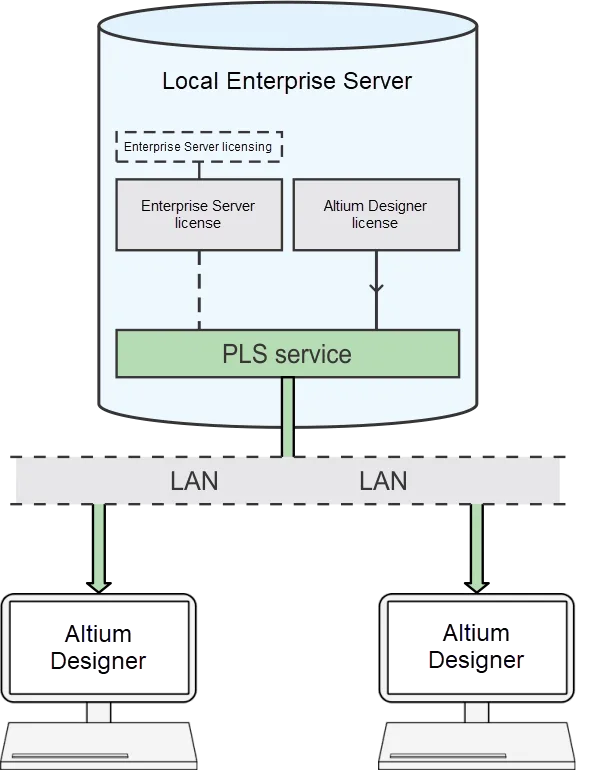
The PLS serves licenses to an Altium Designer installation (client) on the network when the User signs in to the Enterprise Server.
To switch to this mode, select the Local PLS option on the License Manager page in the Workspace's browser interface – Admin – Settings – License manager.

When configuring the No PLS mode, the Authentication mode will directly affect how licenses are served to client installations on the network – see details below.
The PLS will expose licenses to Altium Designer when the user signs in to the Enterprise Server. Server Licenses will become available to other servers on the network when the Enterprise Server PLS is in the 'No Authentication' security mode (see options below).
The Local PLS mode provides additional settings that determine which Users might be offered specific Altium Designer licenses (determined by user groups), and how long a license will remain leased when not used. Click  to confirm any setting changes.
to confirm any setting changes.
Local PLS settings
License Manager Authentication Modes
The server PLS authentication mode can be set to Server Session or No Authentication depending on how you would like to make licenses available to network clients (Altium Designer and servers). Use the License Manager Authentication drop-down menu to make the selection.
Server Session:
The current client connection session is granted access to licenses – a session is instigated by signing in to the Enterprise Server Workspace from Altium Designer. This is the server's standard PLS mode, where license access is bound to an Enterprise Server session. Select Admin – Sessions from the main menu to view and manage the current connection sessions.
Since the PLS connection is verified by an active session in this security mode, licenses cannot be accessed by other servers on the network (which do not sign in) or from the internal PLS setup connection in Altium Designer. Licenses are available when a User signs in to the Enterprise Server from Altium Designer.
No Authentication:
Any connection to the server PLS will be granted access to available licenses. This is a less restrictive mode that can be used for license access where Altium Designer users do not sign in to the Enterprise Server Workspace, or when the Enterprise Server is set up as a central Private License Service (a Licensing Server) in a multiple server configuration.

-
Because PLS connections are not bound to a server session (sign in), available Enterprise Server licenses can be accessed by other network servers in this mode. The other servers must be set to the External PLS mode, with their 'Local licensing' option unchecked so the remote server license is used.
-
Because PLS connections are not verified by a server session, Altium Designer can directly access licenses using the Altium Designer's internal PLS connection – Setup private license server on the License Management page (as was used for accessing PLS 1.0). See Licensing without Server sign in (below) for more information.
-
If a User signs in to a server account, the PLS creates a new user with a name corresponding to that account, in the form of
user_name server_name. The user will only have access to the licenses associated with that generated User account – as determined by its subsequently assigned group membership. This action can be disabled by unchecking the Automatic user creation option (see below).
In practice, the two Local PLS authentication mode options will serve acquired licenses to the network as follows:
Server Session:
-
Altium Designer licenses are available to users that sign in to the Enterprise Server, based on matched User–to–License group assignments.
No Authentication:
-
Altium Designer licenses are available to users that sign in to the Enterprise Server, as determined by the group membership of the generated User profile with the name
user_name server_name.
-
Altium Designer and Altium server licenses are available to other Enterprise Servers that connect using their External PLS mode.
-
Altium Designer licenses are available to the internal PLS setup connection in Altium Designer.
Automatic user creation (No Authentication mode)
When checked (default setting), the Enterprise Server PLS will automatically generate a user account that corresponds to the server sign in account. So if a user signs in to, say, the LicenseServer server using the registered Trevor User account, the PLS automatically creates a User named Trevor LicenseServer (user_name server_name) – this is the 'active' Name that should be used for group membership, and therefore to determine license distribution. See Automatic User sync functionality below for more information.
The corresponding user_name server_name User account is created when connecting from Altium Designer to a remote Enterprise Server PLS – where Altium Designer and the server do not share the same PC host. Conversely, when both the Altium Designer and the Enterprise Server are installed on the same PC, the PLS uses the existing Server sign-in account.
If the Automatic user creation option is unchecked, the server user account (Trevor) will not be able to connect to the PLS (and therefore available licenses) unless the corresponding user_name server_name account already exists. In the majority of circumstances this option should be enabled. The exception might be where the server Administrator wishes to predetermine which Enterprise Server user accounts may be used to connect to the server when in No Authentication mode.
A suitable User account can be manually added by a server Administrator, if required, for when the PLS is in 'No Authentication' mode and Automatic user creation is unchecked. If an existing User Name is Trevor and the server is called LicenseServer, the corresponding PLS account to create is one with the First Name Trevor, the Last Name LicenseServer, and the Username LicenseServer:Trevor. The final result is two User entries: Trevor and Trevor LicenseServer, where the groups applied to the latter will determine the availability of licenses to user Trevor.
In addition, the Enterprise Server PLS will automatically generate a user account (set to the user's Windows Account Name) if a User connects through the Setup Private License Server feature in Altium Designer, rather than signing in to the Enterprise Server – note that the generated User name is in a different format to that described immediately above. See Licensing without Server sign in below.
► See the Existing User section for a summary table of server User profile types.
Seat return timeout interval
The Seat return timeout interval option is included to force a leased license to expire after Altium Designer has not responded to the PLS for the specified number of hours.
The PLS regularly queries a design client over the network and expects a response, however the responses will not be returned if the client's host PC has lapsed into Suspended or Hibernation mode, for example – or if the client application has crashed or been forcibly closed. When client responses have not been received for a longer period of time than the nominated timeout interval (4 hours, by default), the license seat leased by the client will be revoked and returned to the pool of available seats for that license.
This option is effectively a timed, automated version of the manual License Release feature.
Note that when Altium Designer disconnects from a license in the normal 'clean' way (Exit, server Sign out, Disconnect from PLS, etc) a leased license seat is automatically returned.
Automatically create assignment for All Users group
When this Local PLS option is checked (the default setting), newly acquired licenses will be assigned to the default All Users group. The served license will be accessible to all Altium Designer users that connect to the server, regardless of the group a user is assigned to.
When the Automatically create assignment for All Users group option is unchecked, an acquired license is not assigned to any User group and therefore not accessible over the network. The license must be manually assigned to a suitable group via the  button – available when the license entry (Admin – Licenses) is opened in Edit mode (
button – available when the license entry (Admin – Licenses) is opened in Edit mode ( ).
).
Altium Designer License Access (Sign In)
In Local PLS mode, licenses that have been configured and exposed by the Private License Service can be accessed by Altium Designer installations on the network, which act as clients to the PLS. To access an Altium Designer license provided by the Enterprise Server PLS, sign in to your Enterprise Server Workspace from Altium Designer – the dialog associated checkbox can be used to automate the sign in.
When signing in to the Enterprise Server, note that the server name localhost only applies to the local PC. If the server PLS is hosted on different PC on the network, you need to use the network (server) name of that remote PC to sign in – the sign in Server Address field in the dialog refers to that name ([computer_name]). On the PC that's hosting the Enterprise Server, you can go to Control Panel\System and Security\System to confirm its network Computer Name. The recommended method is to always sign in using the server's computer_name:port address.
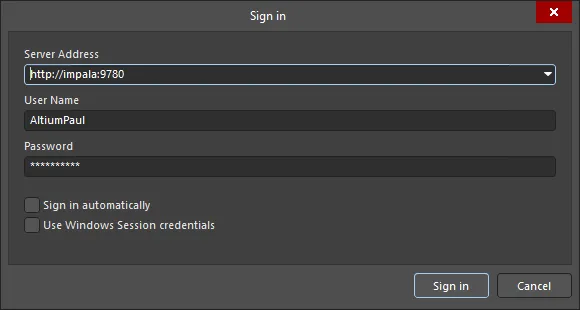
Signing in to server impala in Altium Designer.
You are not required to sign in to a Server. To access licenses from Altium Designer without signing in to the Enterprise Server, if this is the desired approach, use the
Connect to Private Server option on Altium Designer's
License Management view. Note that the server PLS must be set to
No Authentication mode and its
Automatic user creation option should be checked. See
Licensing without Server sign in for more information.
Once Altium Designer is connected to the Enterprise Server and its PLS, the available licenses area of the Altium Designer's License Management view will be populated with the list of private licenses provided by the server's PLS connection. Use the design client's License Management option from the Current User control drop-down menu (upper right) to access the License Management view.
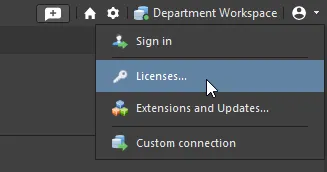
License Management page access in Altium Designer.
To lease a license for the Altium Designer installation, click the Use License button in the tile of the license or right-click the tile and select the Use License command from the context menu. Note that a license hosted by the Enterprise Server may be set to Automatic Leasing mode, so that no user intervention is required in Altium Designer, beyond signing in to the server.
With a license in use, its tile will be labeled with the  icon and highlighted with a green border. The Seats field for the license will update to reflect another seat of that license taken.
icon and highlighted with a green border. The Seats field for the license will update to reflect another seat of that license taken.
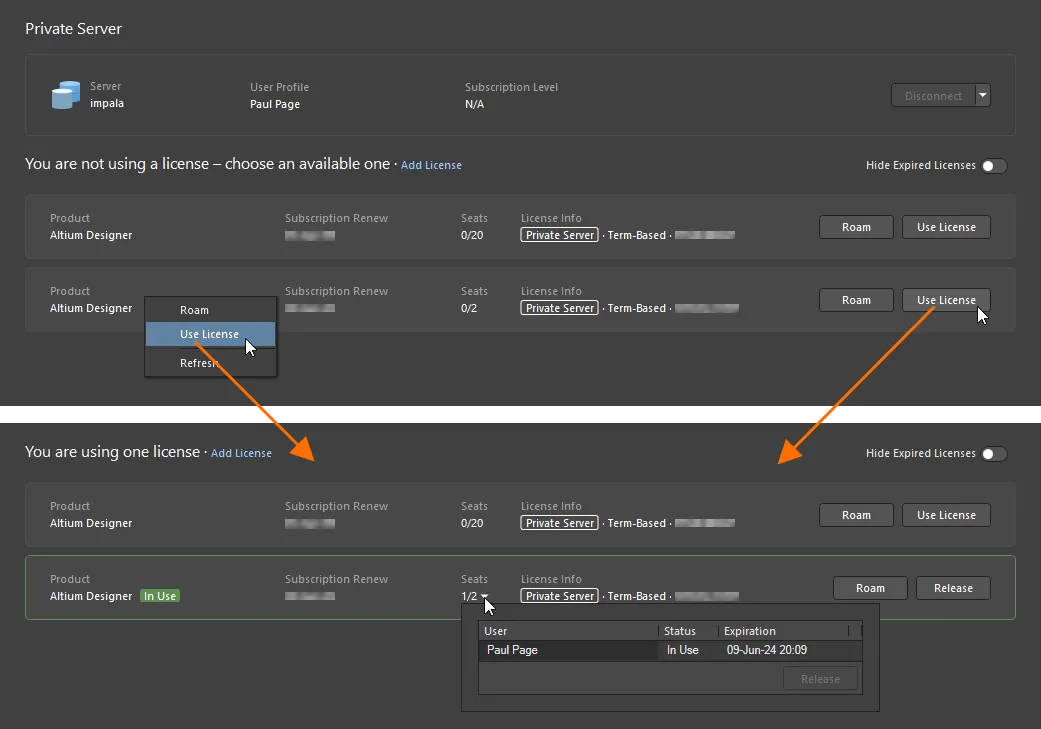
Private Licenses are made available when signing in to the server. Note that Altium Designer's internal Setup PLS option is not used.
Altium Designer users are not required to sign in to an online Altium Account to use a private license, and the local LAN/WAN connection may be isolated from the internet. If required, go to the System – Account Management page of the Preferences dialog to disable the Altium Account connection, and use the System – Network Activity page to select specific network connection services that will be allowed.
The status of the license is also visible in the Workspace browser interface on the License Manager page (Admin – Licenses). Expand the license entry ( ) to see the current leasing details and, if required, to terminate the current user's leasing session by clicking the Release command.
) to see the current leasing details and, if required, to terminate the current user's leasing session by clicking the Release command.

► See the Server PLS mode comparison table for a relative summary of Local PLS mode.
Roaming a Private Server License
A seat of a Private Server license can be roamed, i.e. acquired for a specified time. You do not need to remain connected to the license server to use the license in this mode – you can disconnect and work offline, in essence roaming freely with your license seat.
To use a seat of an available Private Server license in this mode, click the  button in the license tile or right-click the tile and select the Roam command from the context menu. The Retain License dialog will appear in which you can define how many days and/or hours you want to roam with the seat. Enter the number of days and/or hours or use the up/down arrows until the desired number(s) appears.
button in the license tile or right-click the tile and select the Roam command from the context menu. The Retain License dialog will appear in which you can define how many days and/or hours you want to roam with the seat. Enter the number of days and/or hours or use the up/down arrows until the desired number(s) appears.
-
The maximum time that you can roam with a Private Server license in this mode is the life of the actual license itself.
-
If you are roaming with a seat of a Private Server license and the roaming period elapses, use of that seat will stop with no grace period.
-
An administrator of the Enterprise Server can configure the possibility for a license to be roamed and maximum roaming duration from license assignment settings – learn more.
With a license in use in roaming mode, its tile will be labeled with the  icon and highlighted with a green border. The Seats field for the license will update to reflect another seat of that license taken.
icon and highlighted with a green border. The Seats field for the license will update to reflect another seat of that license taken.
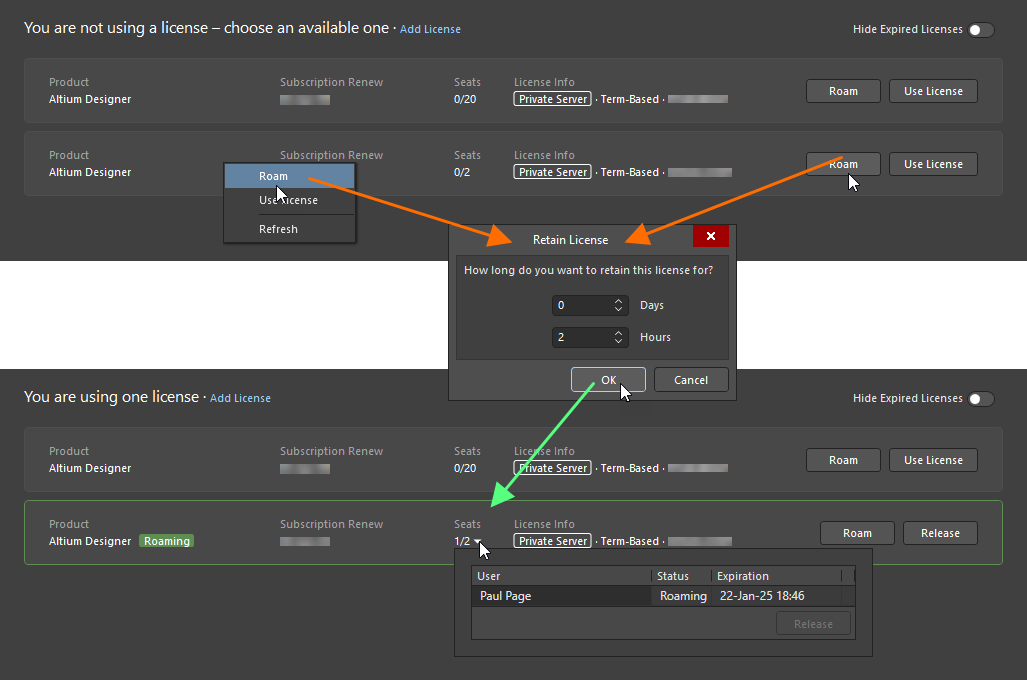
To use a Private Server license in roaming mode, use the Roam option.
When using a license in roaming mode, you are free to disconnect from your license server and work offline. The only time you need to connect to your license server when using a seat of a license in this mode is when you either want to release the license or extend the roaming period. The latter is performed by clicking again on the  button. Then adjust the roaming period as required, using the Retain License dialog.
button. Then adjust the roaming period as required, using the Retain License dialog.
Release of a license that is being roamed is performed by connecting to the license server and clicking the  button in the license tile or right-clicking the tile and selecting the Release command from the context menu.
button in the license tile or right-clicking the tile and selecting the Release command from the context menu.
External PLS mode
The Enterprise Server's External PLS configuration mode is intended for installations where multiple servers are present on the network and one is configured as a central (remote) Private License Service for all users. This type of installation is suited to a larger enterprise, where each company department (Engineering, Development, etc) might use multiple Altium Designer installations and a local department server for design data management purposes. Both the department design data servers and Altium Designer installations are licensed by a central Licensing Service such as the PLS in an Altium Server or an Altium Infrastructure Server, which is dedicated to that task.
In this arrangement the servers are configured as follows:
-
Central Licensing Server – this is set to Local PLS mode (see above) so that all its acquired licenses are served over the network. From the Local (department) Server perspective, this is the external Server that offers the licensing service via its PLS. Note that the Automatic user creation option must be checked (its default setting), as this enables User synchronization between Local and External servers.
For the Central Licensing Server to provide licenses to other servers on the network that are set to External PLS Mode (say, departmental servers), the Central Licensing Server (set to Local PLS mode) must have its License Manager Authentication Mode set to No Authentication.

If otherwise set to Server Session security mode, the Server's Identity Service (IDS) would not allow a PLS connection to another server on the network, because in that mode, connections are verified by and bound to a session created when a User signs in – a server, as you would expect, does not sign in.
-
Local (department) Server – this is set to External PLS mode, and configured to connect to and use the PLS of the Central Licensing Server, in place of the local server's own PLS. The Local Server is therefore using an external PLS (the one in the Central Licensing Server) for licensing, but will still offer its local Data Management services to its connected Users.
To switch the local server to External PLS mode, select the External PLS option on the License Manager page in the Workspace's browser interface – Admin – Settings – License manager.

Set the External PLS URL and port to access the external server that is set up as a central private licensing server.
In this mode, the Enterprise Server connects to and uses an external PLS (such a remote server PLS that has been set up as a Central Licensing Server) in place of its own licensing service (PLS). The network address of the Central License Server in the above image, and therefore the target for the external PLS connection, is http://LicenseServer – this address is based on the computer_name of the license server's host PC.
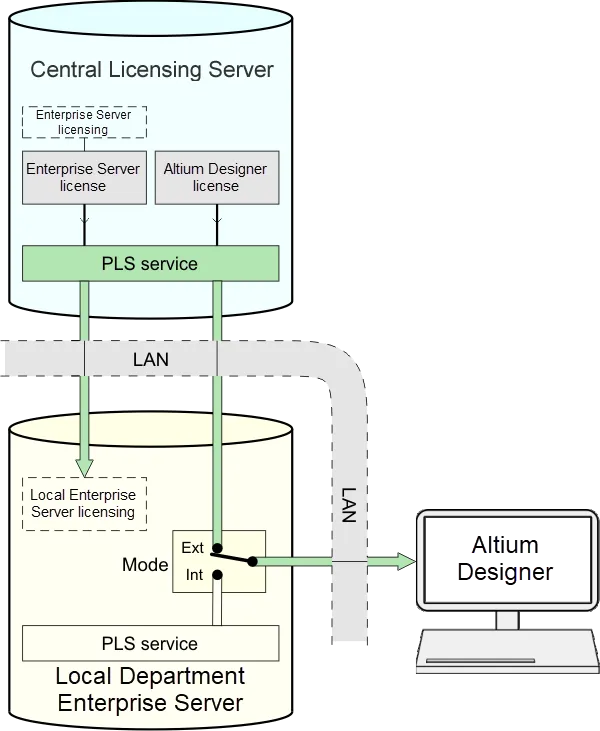
A Local 'departmental' Server, set to External PLS mode, effectively redirects licenses served by the Central Licensing Server's PLS to local Altium Designer installations.
When an Altium Designer user signs in to the Local Server (now set up in External PLS mode), the remote server PLS service is 'redirected' through the local Enterprise Server and will offer its licenses to Altium Designer. As usual, the user must use valid (local) credentials to sign in to the local server.
When using a Central PLS Server arrangement to serve licenses over the network, the groups assigned to Users and Licenses are set up in the Central Licensing Server, rather than Local (department) Server. Local Server group assignments do not apply, since the local server redirects user/license validation through to the central PLS – see the Automatic User Sync section below.
External PLS settings
The External PLS options and settings are as outlined below. Typically, this setup is used for a local/department server where both Altium Designer and server licenses are managed by a remote central licensing service.
PLS url and port
The associated PLS url and PLS Port settings should match that of the external server configuration. The URL is the address (network name) of the remote PC that hosts the 'central' server PLS, as indicated by the host PC's 'Computer Name' entry under Control Panel\System and Security\System. In Windows 10, see Settings » System » About.
Local Server licensing
-
When the Use local license manager for vault licensing option is enabled (checked), the Enterprise Server will be licensed 'internally' by server licenses it has acquired from the Altium License service, or by
alf license files that have been imported from disk or placed in the server's installation folder.
-
When the option is unchecked, the Enterprise Server will be licensed from the external PLS, as nominated by the PLS url and Port settings. The external server (say, a Central Licensing Server) would have Altium Enterprise Server licenses available, with sufficient seats, which it has acquired from the Altium License service. Note that whenever the server has been licensed in a different way, it may need to be restarted to enable its functions.
► See the Server PLS mode comparison table for a relative summary of External PLS mode.
User group license assignment
The Automatically create assignment for All Users group option forces newly acquired licenses to be assigned to the default All Users group. This option is disabled when the above Use local license manager for vault licensing option is unchecked, since in that mode all licenses are sourced from the External PLS, such as the PLS in a remote server used as a Central Licensing Server.
Automatic User sync functionality
As outlined above, to implement a centralized licensing system based on multiple Altium Servers, one server is configured as a Central PLS that serves licenses to Local (say, department) Servers and their assigned Users. The Central Licensing Server is set to Local PLS mode (and 'No Authentication'), and Local Servers are set to Externals PLS mode where their assigned PLS is the remote Central Licensing Server.

When Altium Designer users sign in to their Local Server, they have access to licenses that have been 'redirected' from the (external) PLS in the Central Licensing Server.
Part of the mechanism involved in granting a User access to remote licenses via the Local Server, is the creation of a 'synchronized' user name in the Central Licensing Server – the local User Name is synchronized to the Central Licensing Server. See Automatic user creation in No Authentication mode, above.
The created User profile in the Licensing Server has the composite User account name; user_name server_name, where server_name refers to the network name of the user's Local (Department) Server, and user_name refers to the name used to sign in to that Local Server. The composite name refers to the user's 'local' account.
For example, if user AltiumPaul signs in to his assigned local server (Department Workspace hosted on IMPALA), the PLS in the central server (Licensing Server hosted on LicenseServer) will allow license access by creating a User entry named AltiumPaul IMPALA. The First Name and Last Name of the new user profile will be AltiumPaul and IMPALA, respectively (local department User and Server) – the account's Username is IMPALA:AltiumPaul.

When set to External PLS mode, licenses for a signed in user are sourced from the specified external PLS, which creates a synced user profile (as shown below).

In a multi-server setup (Central License server and Local 'department' Servers), a Local Server user name is synced/replicated in the Licensing Server, if it does not already exist – thereby providing Local access to centralized licenses.
In this case, an Altium Designer license in the remote Licensing Server will be shown as leased by AltiumPaul IMPALA – which is the synchronized AltiumPaul user from the Local Server (the Department Workspace hosted on IMPALA). Even though the Altium Designer user is signed into the local department server, the Altium Designer license is provided by the remote Licensing Server PLS (via the local server). Note that Altium Designer shows a license as leased to the User account Username, which for the created user in this example case is IMPALA:AltiumPaul.
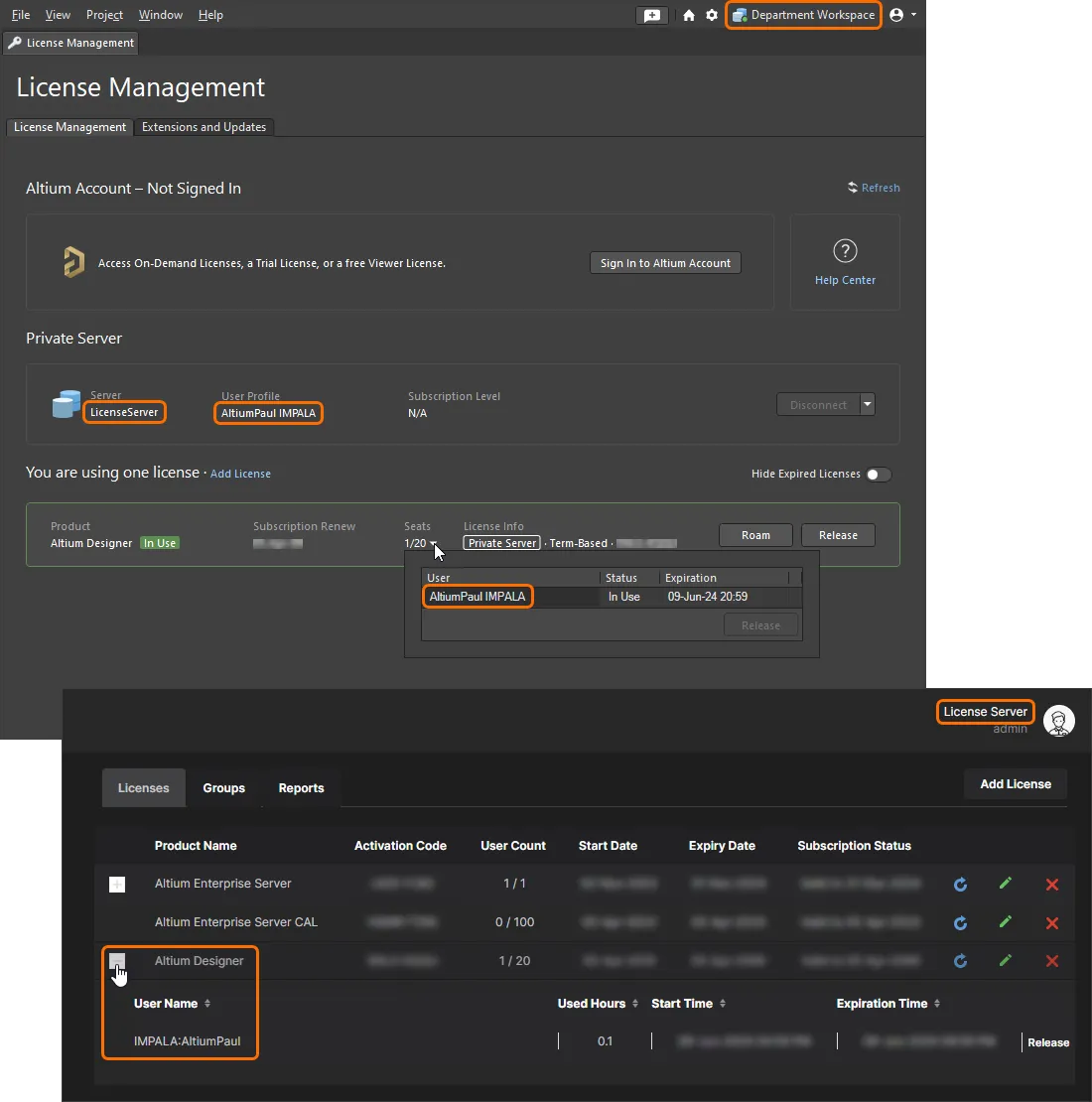
As user signed in to their local 'department' server will transparently access licenses from the central licensing server via their local server.
In general terms, the creation of (synchronized) Users by the PLS occurs when its mode is set to 'Local PLS', 'No Authentication' and 'Automatic user creation'. This the case for a Server PLS set up as a centralized License Server in a multi-server Central/Local arrangement, but also true for any Server that has been set to that mode (Local-PLS/No-Authentication/AutoUserCreation).
Licensing Server Group
User profiles that have been synchronized to a Central PLS server in a multi-server setup can be added to groups, just as with any other Server set to Local PLS mode.
In the case of a server arrangement that consists of a central Licensing Server and distributed Local Servers (as detailed above), the duplicate (synced) Users in the Licensing Server can be added to groups to constrain license availability. Therefore, when a User signs in to a Local Server, the licenses made available to the User (from the external Licensing Server PLS via the Local Server) will be determined by the groups and License assignments configured for that synchronized User in the central Licensing Server.
In the above example, the synced user AltiumPaul IMPALA (the AltiumPaul user synced from the Local Server) in the Licensing Server might be added to an Engineering group, which has a particular Altium Designer license assigned to it. When user AltiumPaul signs in to their local server, the specified license will become available by virtue of the associated user group and License assignment configuration in the external Licensing Server.
Generally, these user group and License assignments would be implemented by the Licensing Server administrator, once a Local Server user has signed in for the first time (thereby instigating the User sync process).
See License Group Assignments below for more information on working with groups and license assignments.
Licensing without Server sign in
For Altium Designer users who do not use the data management capabilities of the Enterprise Server, and therefore do not sign in to the server, Altium Designer can access licenses from the server's PLS using Altium Designer's internal PLS setup (as outlined below). For this approach, the Enterprise Server is set up as follows:
-
The server's PLS mode is set to Local PLS, so that licenses are made available on the network.
-
The PLS must be set to the 'No Authentication' security mode, since in this arrangement, a server Session will not be established by server sign in.
-
The server PLS has a suitable Altium Designer license available that is assigned to All Users, so that it is accessible by any connection to the server.
The below method of accessing and using Altium Designer licenses also applies to the legacy Private License Server (PLS 1.0) that is installed as a Windows service.
License access within Altium Designer
To access the Server-hosted licenses in Altium Designer (without sign-in), select Connect to Local Server on the License Management view (use the Licenses option from the Current User control drop-down menu to access the License Management view). The Private License Server Setup dialog will open.
If you are signed in to your Altium account, use the Connect to Local Server option from the Add License control menu to access the Private License Server Setup dialog.
Enter the basic server details for the PLS in the Private License Server Setup dialog, and click OK. The server name will be the network (computer) name of the PC that is hosting the Enterprise Server, and the standard port is 9780 – use port 9785 and the server's FQDN to establish a secure https connection (see example ). The other dialog settings, such as the Servers list options apply to the legacy PLS 1.0 type connection.
). The other dialog settings, such as the Servers list options apply to the legacy PLS 1.0 type connection.
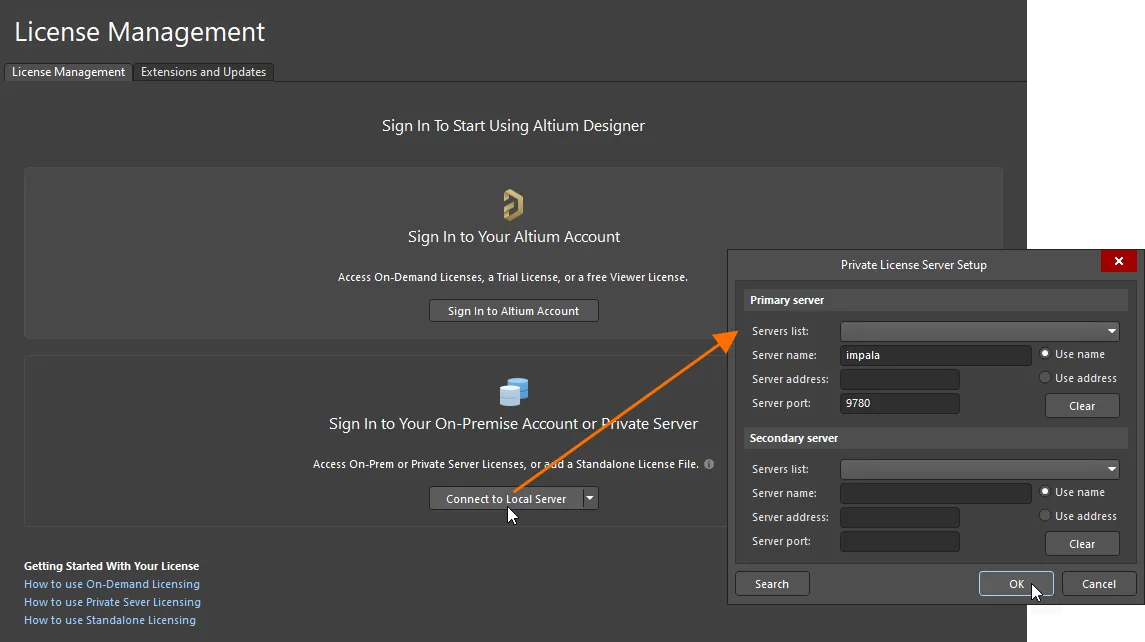
Note that only the Server name and port entries are required when using Altium Designer's internal setup to access PLS licenses. The behavior is different when connecting to the legacy PLS 1.0.
Once connected to the PLS, the available licenses area of the License Management view will be populated with a list of private licenses that you are able to use.
When establishing a license connection to the PLS using this approach, the License must initially be set to the 'All Users' group in the Enterprise Server (the default setting). Once the license is recognized by Altium Designer, a matching User profile is automatically generated in the server, as detailed below. That generated User profile may then be added to a group, whose members have access to specific licenses – this allows the server administrator to control license access for Users that do not sign in to the server.
To lease a license for the Altium Designer installation, click the Use License button in the tile of the license or right-click the tile and select the Use License command from the context menu. Note that a license hosted by the Enterprise Server may be set to Automatic Leasing mode, so that no user intervention is required in Altium Designer, beyond activating the Private license server connection initially.
With a license in use, its tile will be labeled with the  icon and highlighted with a green border. The Seats field for the license will update to reflect another seat of that license taken. On the server side, the license entry on the License Manager page (Admin – Licenses) will show that a seat has been taken by a User Name derived from the Altium Designer's host PC – see the below section for more information.
icon and highlighted with a green border. The Seats field for the license will update to reflect another seat of that license taken. On the server side, the license entry on the License Manager page (Admin – Licenses) will show that a seat has been taken by a User Name derived from the Altium Designer's host PC – see the below section for more information.
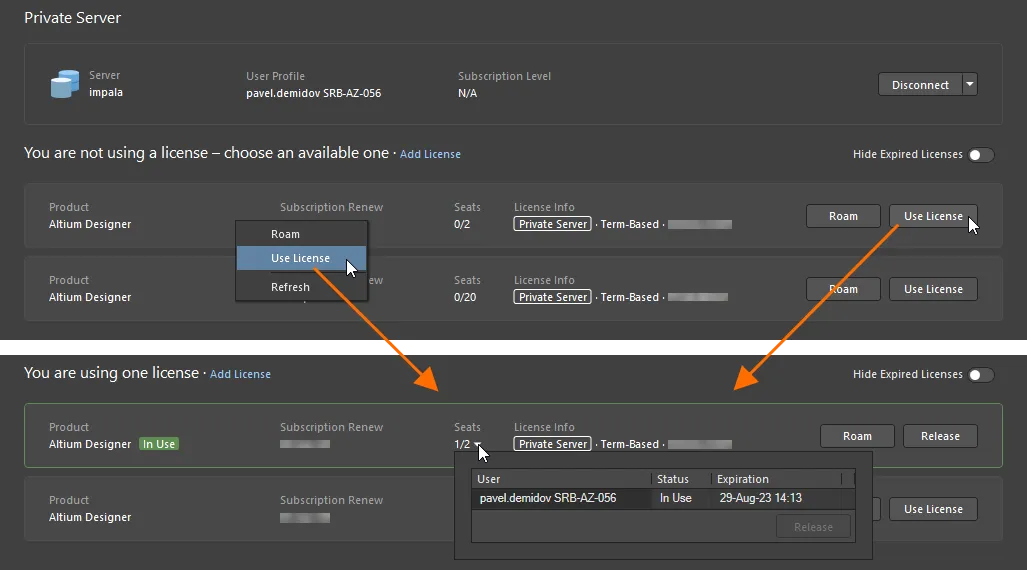
-
Altium Designer users are not required to sign in to an online Altium Account or the Enterprise Server to use a private license, and the local LAN/WAN connection may be isolated from the internet. If required, go to the System – Account Management page of the Preferences dialog to disable the Altium Account connection, and use the System – Network Activity page to select specific network connection services that will be allowed.
-
When accessing the Server-hosted licenses in Altium Designer without signing in, a license can also be used in roaming mode. Refer to the Roaming a Private Server License section above to learn more.
Created Users
When a user has connected to the Enterprise Server PLS from Altium Designer without signing in (as described above), a User profile is created in the server that matches the connecting Computer Name and its active Windows User Account Name – that is, the computer and Windows account that hosts Altium Designer.
For example, a user might be using a Windows account called Design on a computer named PC4. When Altium Designer's Connect to Private Server option is used to access a license, the server PLS that hosts that license will create a user named Design PC4, with First/Last Name Design/PC4 and a Username Design.
Note that the created User Name is in a different format to the User name created in response to a user
signing in to the server, as outlined in the
Automatic user creation section. In both cases the PLS is set to
No Authentication mode, however when a user has signed in, the created User name is based on the sign-in name and the server name (
user_name server_name). When
Connect to Private Server feature is used (no sign-in) the created name is based on the user's active Windows account (
user_account_name), as outlined here.
Again, this is the server User Name that may be added to group(s), which in turn will determine which licenses are made available to this user on that computer.

See below for more information on group and license assignments.
License Group Assignments
To control license availability for Altium Designer users, the Enterprise Server's PLS can be configured to associate specific licenses with defined user groups. In practice, when a user signs in to the server, the PLS will offer only those licenses that are assigned to groups that have the user as a member.
Users and user groups may be already registered in the Enterprise Server if it is currently in use for managing and storing Altium Designer design data. Licenses hosted by the server are assigned to 'All Users' by default, but can be reassigned to any available group. Similarly, Users can be added to any available group.
Users
To add a new user profile and add it to a group, select Users from the browser's main menu to see the list of registered Enterprise Server user names, then select the  button.
button.

Add the new User's details in the pop up Add User dialog and click the  button to commit the changes. The dialog includes a couple of notable entry fields:
button to commit the changes. The dialog includes a couple of notable entry fields:
-
Authentication: The default Built-in option will identify the User connection using the Enterprise Server's own Identity Service (IDS), whereas the Windows method applies when the host PCs are part of a Windows Domain, and Windows Domain Authentication will be used.
-
Add Groups: The new user can be added to an existing group by entering the group name in this field. The field will dynamically search for an existing group that matches the first letter(s) you have typed – select the group name to confirm your choice. By default, users are not included in a group.
Groups
To add a new group and then add an existing User as a member, select Groups from the browser's main menu to see the list of existing group names, then select the  button.
button.

Add the name of the new group in the Create Group dialog, and include any Users you would like as members of that group. The Add Members field will dynamically search for an existing User that matches the first letter(s) you have typed – select full the Member name to confirm your choice. Click the dialog's  button to commit the changes.
button to commit the changes.
Existing Users
Existing users can be made members of a group (or groups) by editing their user profile. Select the user entry on the Admin – Users page and click the  button at the top-right of the listing to open the Edit User dialog, check groups you wish to add in the Existing Groups list and then click the
button at the top-right of the listing to open the Edit User dialog, check groups you wish to add in the Existing Groups list and then click the  button to commit the changes. A group can also be added by typing into the Add Groups field, as described above.
button to commit the changes. A group can also be added by typing into the Add Groups field, as described above.

Note that an existing User can be represented in a number of formats, depending on how they were added. The formats include standard Username/Firstname/Lastname entries, and entries that have been automatically generated by the PLS in response to incoming connections that do not instigate a server Session by sign-in.
| User |
Username |
First Name |
Last Name |
Account Creator |
Circumstances |
| Trevor Smith |
Trevor |
Trevor |
Smith |
Manually entered |
A standard User account, added by a Server administrator. |
| Design PC4 |
Design |
Design |
PC4 |
Auto-generated |
An Altium Designer user, working from the Design Windows Account on computer PC4, has connected to the PLS without signing in to the server. |
| Trevor CADDESIGN |
CADDESIGN:Trevor |
Trevor |
CADDESIGN |
Auto-generated |
User Trevor has signed in to his account on the Enterprise Server CADDESIGN, which has its PLS set to 'No Authentication' mode. Also, in a Central/Local arrangement of servers, when Trevor signs in to his Local Server (CADDESIGN, set to External PLS mode), the User Trevor CADDESIGN is generated in the Central Server PLS (which is set to 'No Authentication' mode). |
In all cases, these User profiles can be made members of groups by editing the user entry. Note that in a Central Licensing Server and multiple Local Servers arrangement (see External PLS mode), User group membership is applied in the Central PLS for licensing purposes, rather than at a Local Server level.
In a Central/Local multi-server setup, the User configuration process would be, typically:
-
Create a standard User Account on the User's Local/Department Server (which is set to 'External PLS' mode, pointing at the Central Licensing PLS).
-
Ask the User to sign in to the new account on the Local Server – this will synchronize the User Name to the Central PLS (in the form
user_name server_name)
-
In the Central PLS, edit the new synchronized User entry to make it a member of the required group(s). Licenses are assigned to groups, allowing access by users – see below.
License Assignments
In Local PLS mode, the Enterprise Server PLS can selectively offer Altium Designer licenses that have been assigned to a specific group, which in turn, can be associated with a server User account. By default (unless otherwise specified), all licenses acquired by the Enterprise Server are assigned to the 'All Users' group, and therefore available to any User that connects to the PLS.
To view and edit the existing license group assignments, go to Admin – Licenses in the Workspace's browser interface and select the Groups tab. Click on a group name in the Groups column to see its User members, and on the right, its assigned licenses.
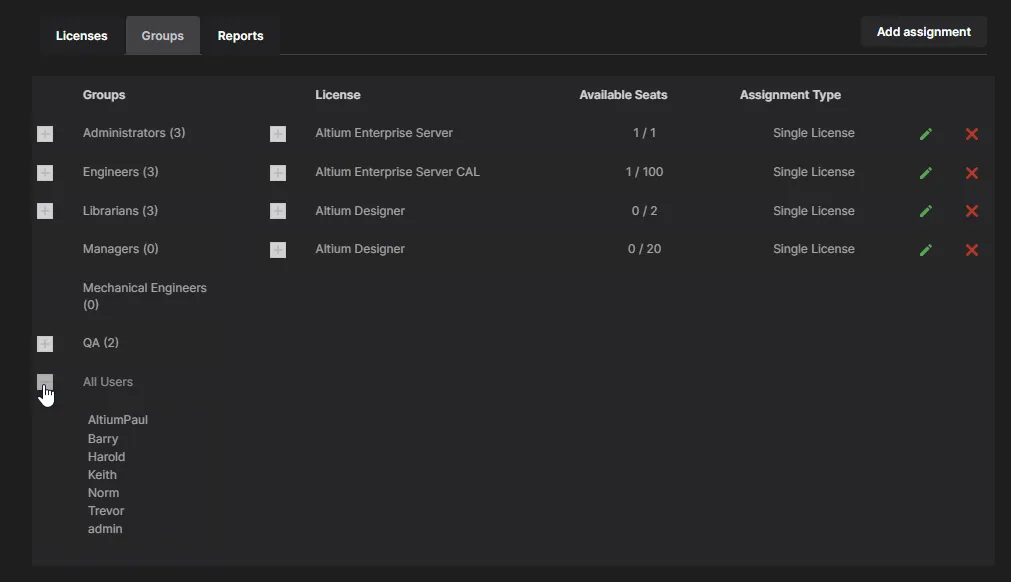
A license can be assigned to a group by opening the Add/Edit assignment dialog with the  button, then selecting an available license, its target group and the assignment options.
button, then selecting an available license, its target group and the assignment options.
The License type, the specific License, and the proposed group assignment are all selectable from drop-down menus, which will be populated with a list of those currently available. In the below example image, 10 seats of a specific 20-seat Altium Designer license are being assigned to the Engineers group.

The license assignment options include:
-
Automatic leasing: Forces Altium Designer to automatically lease (use) this license when it becomes available. In Altium Designer's License Manager, the normal process of choosing the license from the list and selecting Use is performed automatically, for this license.
-
Seat availability: Specify the number of License seats (up to its total seats rating) that will be made available for the associated group, or simply check the All available seats option to enable the total number of seats for that License (its User Count attribute)
-
Roaming: Allow a License to be 'roamed' (used by Altium Designer when its host PC is not connected to the network) by selecting the Allow Roaming option. The Max roam duration setting will configure the license to disable a 'roamed' seat after the nominated period. Enter 0 to allow unlimited roaming (for a term-based license, roaming will be effectively limited by the license's expiration date). See the Roaming a Private Server License section for more information.
-
Automatic seat release: Allow a seat of an Altium Designer license to be released when the client machine is in an inactive, or idle state, i.e., when there is no mouse or keyboard activity on the client machine and no long-term Altium Designer process such as project release is currently in progress, by enabling the Release seats on inactive clients option. The Lease verification interval (hours) setting specifies the time period between sending verification requests from Altium Designer (if there was no activity in the previous period, the seat will be released provided the Release seats on inactive clients option is enabled). Enter a value from 1 to 12 hours. Note that the automatic release due to inactivity functionality is available in Altium Designer 25.1 or a later version.
-
Notifications: Notifications are messages that will be sent to users in response to particular events, such as when a specified percentage of the available license seats have been leased, or if an attempt at leasing a seat fails. Note that email notifications are not available until configured and enabled – see Configuring Email Notifications.
-
When the Notify when <x>% of available seats have been leased option is enabled and the number of leased seats reaches (or exceeds) this percentage, then a related notification email will be sent to the group specified in the Send to users with role field. See example.
-
When the Send reject notifications option is enabled, an error email will be sent to the above group when a user attempts to lease an unavailable license seat – for example, where a remaining seat is shown as available in the (unrefreshed) Altium Designer License Management view but has since been leased by another user. See example.
When the new license assignment configuration is complete, click  to commit the assignment to the selected group. For detail about the assigned license, select the expand option (
to commit the assignment to the selected group. For detail about the assigned license, select the expand option ( ) associated with its entry.
) associated with its entry.

It is important to note that Licenses may have an All Users assignment by default, so this assignment will need to be removed to make a license exclusively assigned to another group, and its constituent users.
In the above license assignment scenario, 10 seats of a 20-seat Altium Designer license have been assigned to the Engineers group and therefore its members. If the default All Users group assignment associated with the license was not otherwise removed, and both assignments existed, the license would not be available exclusively to members of the Engineers group – it would be available to all server users.
To remove an existing license assignment, click the delete button ( ) associated with its entry. A license assignment can be edited via its associated
) associated with its entry. A license assignment can be edited via its associated  button.
button.

The Groups tab provides an aggregate view of the current groups, their constituent Users and the Licenses assigned to each group. This versatile interface can be used in combination with how users are grouped (set up under the main Users pages) for a flexible approach to allocating licenses and seats to Users.
Manage Licenses
The Enterprise Server-based Private License Service (PLS) offers a range of administration features for managing license allocation and usage, including the ability to forcibly release a leased license and closely monitor how licenses are used.
Release a license in use
For situations where a license has been in use by Altium Designer but not correctly released by the software, the PLS offers provides a means of terminating that lease and returning the seat to the pool of available license seats. This can occur when the PC has lapsed into standby while Altium Designer is active, or through some form of software crash that has prevented a clean exit. In practice, that license seat is still registered as being in use and therefore denied to another user.
To locate the license of concern in this situation, go to the Licenses list in the Workspace browser interface by selecting Admin – Licenses. Within the list of licenses shown under the Licenses tab, the leasing information for each entry is available by expanding the license entry with the  button – use this to find the user that still retains the license seat.
button – use this to find the user that still retains the license seat.
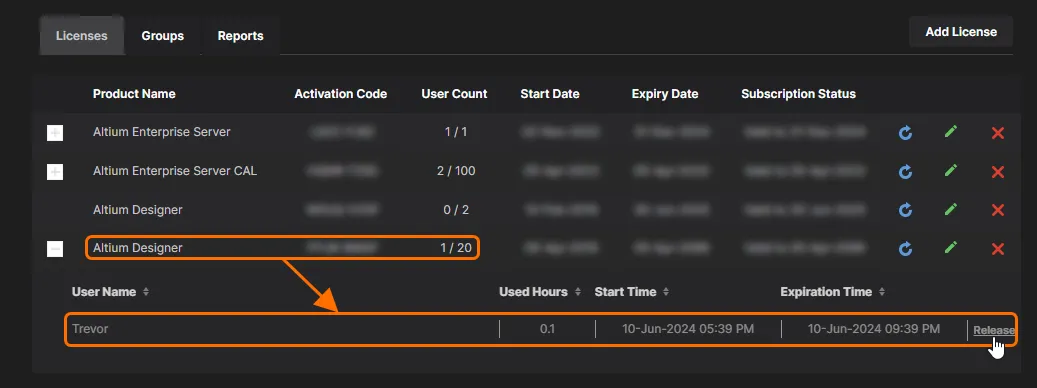
The license leased to that user can be terminated, and the seat returned to the license pool, by clicking the Release link associated with the user entry and then confirming the action in the Release seat dialog. Altium Designer will notify the user that the license has been forcibly released by an administrator.

Monitor License Usage
The Enterprise Server provides a range of license usage monitoring and reporting features that can be used to audit how Altium Designer licenses are used within an organization. This is useful for ensuring that the best use is being made of the available license seats, for anticipating future license requirements and to determine the usage of individual Users.
The server license usage features are accessed through the browser interface under the Reports tab on the License Manager page (Admin – Licenses). This offers an extensive range of reporting options that are accessed by specific tabs within the Reports view. The following types of reports are available:
-
Real Time Usage
-
Usage History
-
Usage Log
-
Time Log
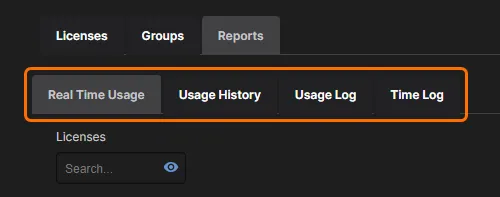
Depending upon the type of information that's required for each report, the associated reporting filters can be applied to tailor the results to include specific licenses, groups, users and time periods.
-
To filter the usage reporting results to show the activity of a particular License for example, select the license of interest from the Licenses drop-down menu and click
 – show example. Additional licenses can be added as needed – licenses are differentiated by their Activation Code.
– show example. Additional licenses can be added as needed – licenses are differentiated by their Activation Code.
-
The filtering action of the options remains in effect while each reporting style tab is selected, allowing you to see usage reports that are constrained to that license.
-
The Reports page also offers the option to export the current report to disk in CSV format – compatible with Microsoft Excel and other spreadsheet applications – for administration and accounting purposes. Select the desired report results using the appropriate tab and filtering for your needs, click the
 button and nominate a location to save the file to disk.
button and nominate a location to save the file to disk.
Real Time Usage
The real-time usage report provides a detailed summary of how the Private Server licenses added to your Enterprise Server are currently being used.
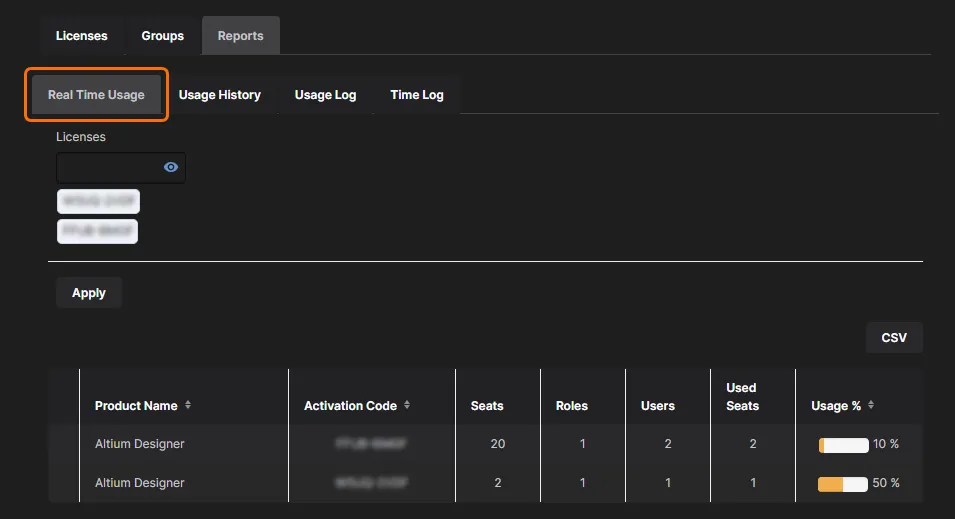
Usage History
This type of report provides a detailed history of how the Private Server licenses added to your Enterprise Server have been used. By default, the report lists usage for the previous year, across all used Enterprise Server licenses, groups and users. Use the associated reporting filters at the top of the page to tailor the results to:
-
A specific Time Interval for the included entries – either the previous year, previous quarter, previous month, or a customized reporting interval of your choosing.
-
Include specific licenses and/or groups and/or users, as required – this will filter the results by these settings.
-
Group the listing entries by a specific time frame (Year, Quarter, Month, Week, or Day) and optionally one or more other fields (Product Name, Activation Code, User, Role). For example, you might want to see license usage over a particular timeframe, and collate that by your defined groups – so selecting Role in the And drop-down field. Extending this further, you could group by Role and Product Name to get a history of usage of every product for every group.
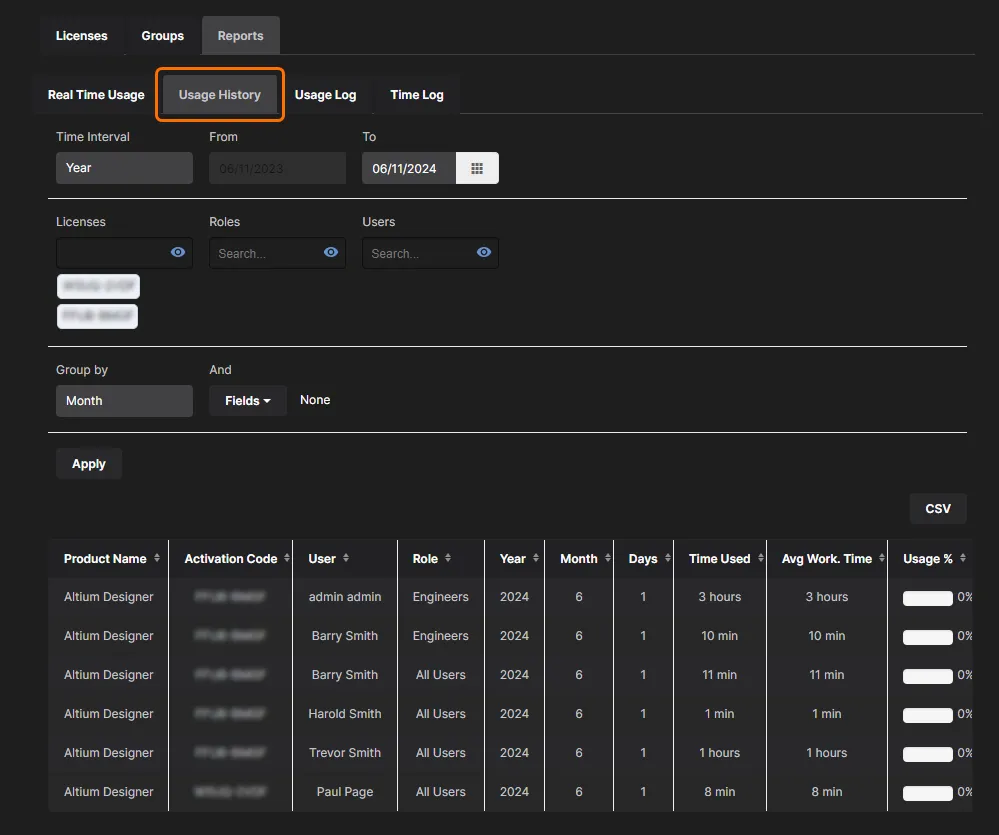
Along with time-logged data for each active user, the report listing provides an approximate working time (Avg Work Time) based on the logged Time Used over the number Days in which the license was used. A figure is also calculated that represents the average use of Private Server license seats over a specified period. Shown as a percentage (Usage %), this can help in deducing how fully your licenses capacities are being used, subject to the applied filtering.
More about License Usage
The report's license Usage figure for each entry is calculated from several variables to show an aggregated occupancy percentage over a specified period.
As a basic example, if a single seat license has been used for 8 hours on a given day (24 hours), then the Time Used is 8 hours, the Avg Work Time is 8 hours, and if Group by is set to Day the license Usage is 33%.
If the same scenario – one seat used for 8 hours – is applied to a license with a 3 seat capacity, then the Usage figure will drop to 11% since only one seat of the 3 available will be taken by the user during that period.
The above examples would be shown when the Group by option is set to Day. If the group setting is changed to Week, and as is the case above, a single seat license is used for 8 hours, then the license Usage will be 5% because it was used for one seventh of the specified time interval – 8 hours of a 168 hour week. The Usage would be reduced by a further fifth for a 5-seat license (to approximately 1%), since only one seat of that license's capacity is used.
So in short, a user’s license Usage is calculated as the Time Used proportioned by the license’s seat allocation and the number of days in the selected period (Group by), and 24 hours per day.
The above calculation equates to:
Usage % = 100 x Used hours / (Seats x Group days x 24)
Note that number rounding is used in calculated report data, so figures such as license Usage are approximate only, particularly when the Group by period is set to the shorter intervals.
Usage Log
This type of report provides a detailed usage log for the Private Server licenses added to your Enterprise Server, in terms of:
-
Who has used the license, and in which group they were assigned that license.
-
What version of the software they were using.
-
When they started using the license.
-
When they released the license (back into the pool for use by others on the account).
By default, the log reflects usage for the previous year, across all used Private Server licenses, groups and users. Use the associated reporting filters at the top of the page to tailor the results to:
-
A specific Time Interval – either the previous year, previous quarter, previous month, or a customized reporting interval of your choosing.
-
Include specific licenses and/or groups and/or users, as required.
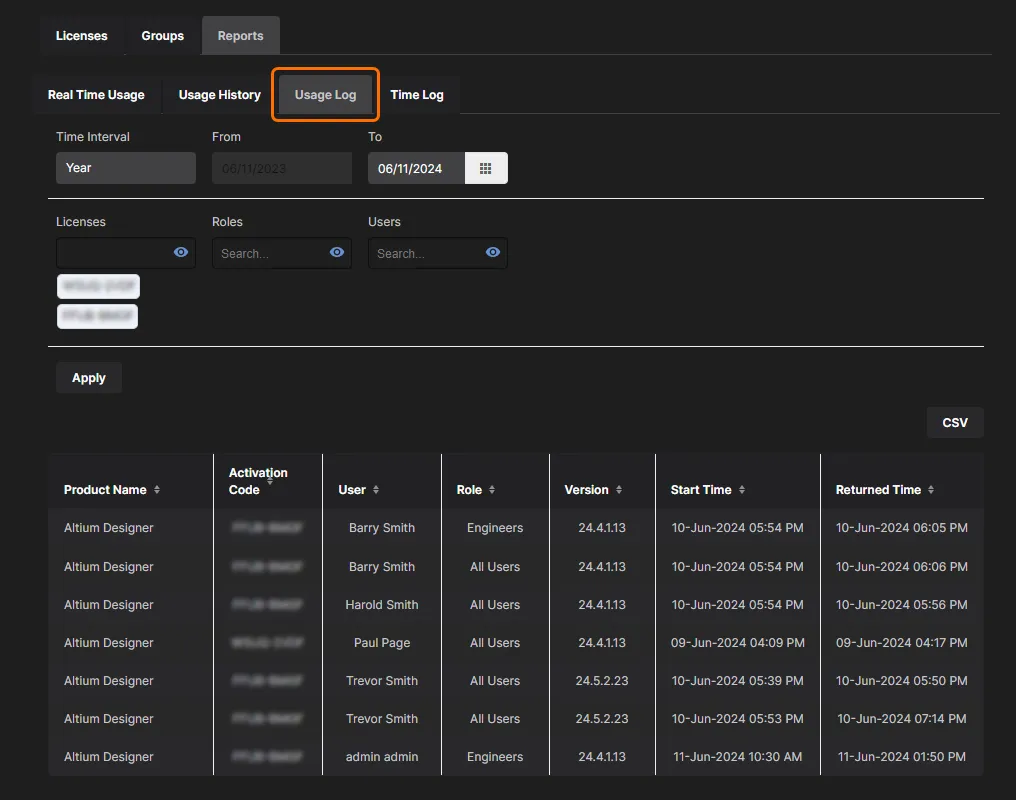
Time Log
This type of report provides a detailed time log for the Private Server licenses added to your Enterprise Server, in terms of:
-
Who used a seat of a specific license, and in which group they were assigned that license.
-
The time they took the license seat (Action = IN).
-
The time they released the license seat back into the pool for use by others on the account (Action = OUT).
By default, the log reflects timing events for the previous year, across all used Private Server licenses, groups and users. Use the associated reporting filters at the top of the page to tailor the results to:
-
A specific Time Interval – either the previous year, previous quarter, previous month, or a customized reporting interval of your choosing.
-
Include specific licenses and/or groups and/or users, as required.
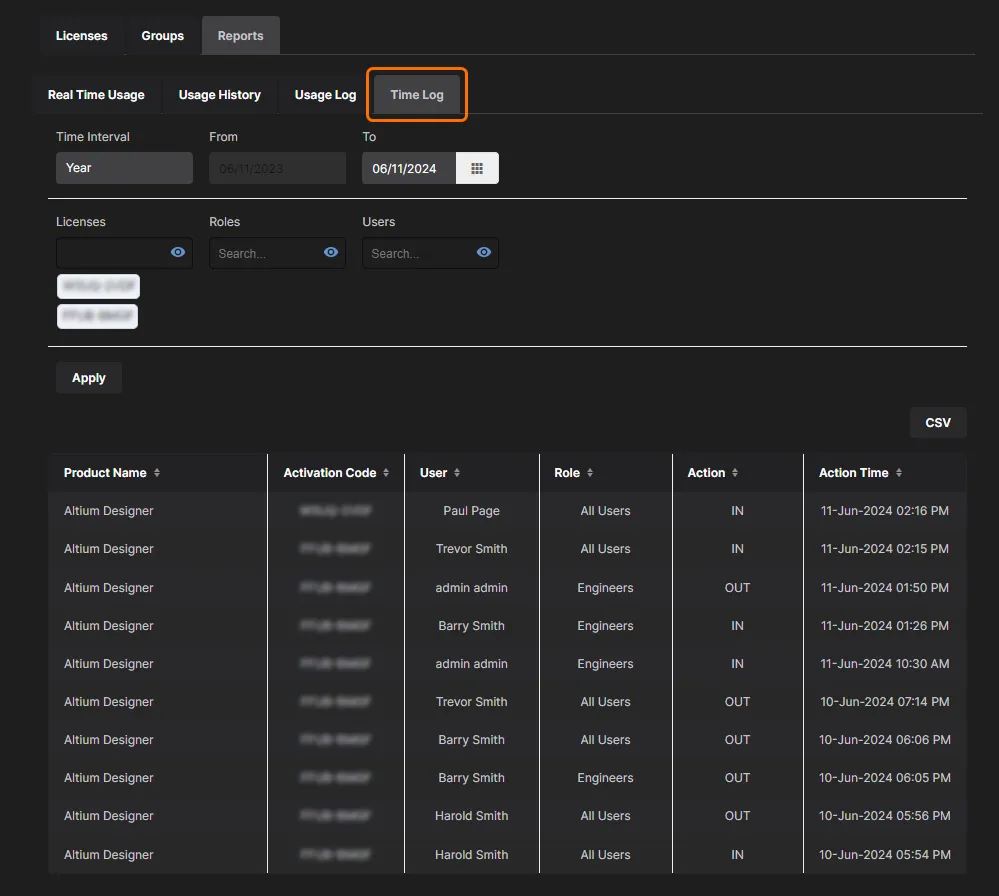
Troubleshoot License Access
If Altium Designer is not able to connect to the Enterprise Server PLS, or licenses that you have acquired and configured in the PLS are not appearing in Altium Designer's Available Licenses list, there may be system or software settings that are preventing access.
When troubleshooting any issues, consider the following:
-
Host PC Firewall – the Enterprise Server PLS uses port
9780 by default when transferring licensing data on the network. Check that this port has been opened in the host PC's firewall during the server's installation.
-
Allowed network connections – Altium Designer offers the System – Network Activity page of the Preferences dialog. Check that the 'License Server' entry is checked, so the server PLS can communicate with Altium Designer over the network.
-
Try basic tests:
-
Check locally – if the server PLS is set up on a PC that also hosts an Altium Designer installation, confirm that the PLS is accessible to that local installation before troubleshooting remote PCs. If the PLS and private licenses are available locally, this indicates that PCs elsewhere on the network that cannot connect have a network or Altium Designer (rather than PLS) configuration issue.
-
Assign license to All Users – If a license that has been assigned correctly in the PLS is not available for lease in Altium Designer, temporarily change the license group assignment to All Users (or simply create a new All Users assignment for that license). See License Assignments, above. If then available, this indicates there was a problem with the user group or license assignment.
-
Refresh the server PLS – after making changes to the server PLS license setup, particularly when adding or removing acquired server licenses, you may need to Log out then back in again to see the changes. In some situations it may be necessary to restart the Enterprise Server, by either rebooting the PC or using the server Restart feature in Windows' IIS Manager.
-
Refresh the Enterprise server's PLS connection – after making changes to license access in the server PLS or Altium Designer, re-establish the connection to the Enterprise Server by clicking the Refresh command on Altium Designer's Licensing Management page or by signing out then back into the server. When using the internal PLS setup to access licenses in Altium Designer, refresh the connection by clicking Refresh and/or the Disconnect/Reconnect... private license server link. To force a full connection refresh, select the Setup private license server link and click OK in the Private License Server Setup dialog.
-
Check Groups and PLS Authentication mode – if a license you are attempting to access by signing in to the Enterprise Server is assigned to a specific group, make sure that server user Account name is a member of that group – note that in the PLS 'No Authentication' mode, groups are assigned to the generated
user_name server_name account. Conversely, if you are connecting to the PLS using the 'Setup private license server' option in Altium Designer, the Enterprise Server authentication must be set to 'No Authentication'.
Enterprise Server PLS Mode comparison
The Enterprise Server PLS can be set to one of three distinct modes, each of which will suit particular licensing arrangements for Altium Designer and Altium Servers. The below table summarizes how the PLS manages and offers Altium licenses, when set to each PLS mode.
| |
No PLS mode |
Local PLS mode |
External PLS mode |
| Server license location: |
Local |
Local |
Local or External |
| User authentication: |
n/a |
Server Session |
No Authentication |
n/a |
| Altium Server licenses served to network: |
No |
No |
Yes |
Yes – Licenses sourced from external server PLS. |
| Altium Designer licenses served to network: |
No |
Yes |
Yes |
Yes – Licenses sourced from external server PLS. |
| Altium Designer license access using internal PLS setup: |
No |
No |
Yes |
No |